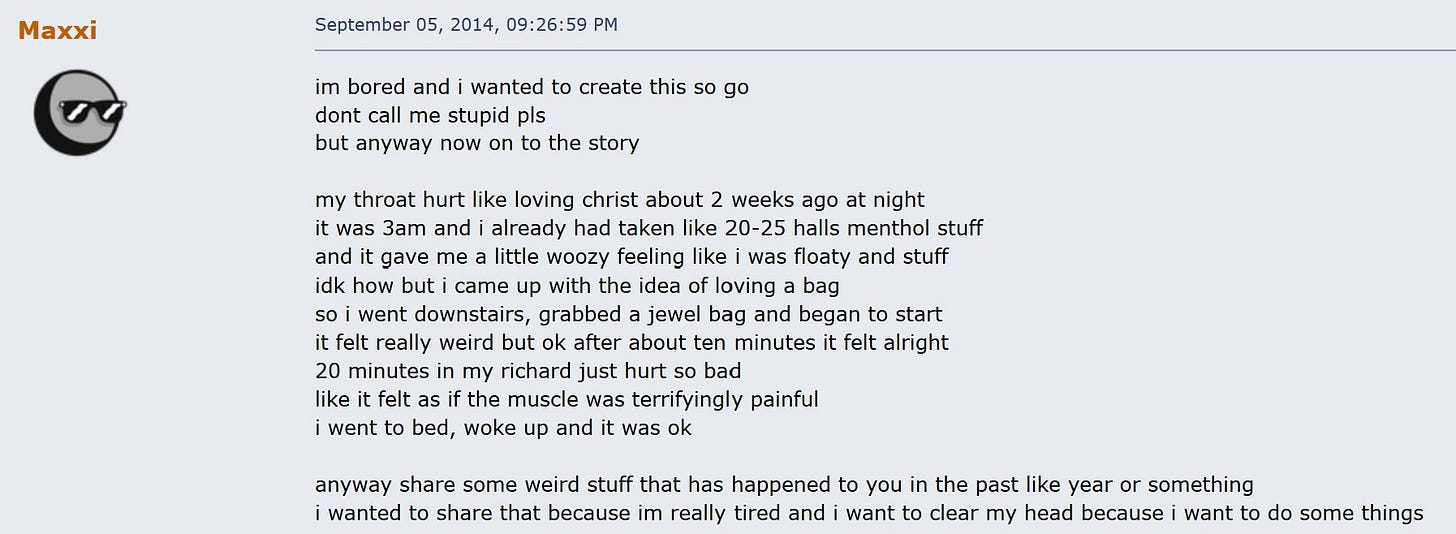You ever see a picture on the internet that you spend hours trying to figure out? You can tell that it means something — usually something terrible — but you’re not sure precisely what? That happened to me last week.
Here is the image in question:
(If you don’t want to zoom in, it’s a series of dominoes. The smallest one is labeled “making fun of someone for fucking their mom’s purse in 2014” and the largest is “the destruction of valve’s source engine and the valve news network.”)
Let’s work backwards. Last week, someone leaked the source code for two games made by software developer Valve, Counter-Strike: Global Offensive and Team Fortress 2, both of which run on Valve’s Source Engine. A game engine is a foundational set of code that a game runs on. An analogy I remember (from the back page of an issue of EGM from like 2007) is that building a game engine from scratch is a lot like inventing a film camera whenever someone wants to make a movie. Sharing an engine between games is theoretically more efficient, though certain engines are better for certain types of games. All of Valve’s games, including Half-Life, Portal, Dota 2, Counter-Strike, Team Fortress, and Left 4 Dead, use the Source Engine
The flip side is that because an engine is shared between software, a vulnerability discovered in one game could be replicated in another. That was the worry when the CS:GO and TF2 code leaked last week — the Source engine powers a number of other titles. Players warned of the possibility of remote code executions, now that the exploits were out in public. Valve clarified that the leak was old code from 2017 and 2018 (it had apparently leaked before, but less widely) and that anyone running current versions of CS:GO and TF2 were safe to keep playing the game on official servers.
Still, questions remained. Where did the code come from?
According to Tyler McVicker, who runs the YouTube channel Valve News Network, the code was made available to a small group of Source modders and licensees, people who make add-on content (like new weapons for TF2, for instance.) Included in the leak is a chat transcript between McVicker and a Valve employee using the pseudonym Cephalon, who leaked information about an abandoned version of the vaporware game Half-Life 3.
Subsequent chatter last week identified the leaker as being a member of a Discord community called Valve Cut Content, which plumbs the depths of Valve leaks and hidden artifacts buried in source code to find unfinished work that Valve abandoned. Another piece included in the cache of code was an attempt to recreate F-Stop, a prototype idea Valve made while working on Portal 2. The F-Stop code was put together by Lever Softworks, a modding group also led by McVicker.

People close to the leak have said that it was catalyzed by the leaker being kicked out of the modding group for problematic behavior including but not limited to racism, homophobia and transphobia. It’s seemingly clear who the culprit is, but nobody involved has identified them by name. “I know exactly who did this, and unfortunately for that person, it’s entirely possible to find out just by looking at the F-Stop modding build and referencing the save files,” McVicker wrote on Discord.
The leaker is apparently a user by the name of Maxx, according to data in the files. Google cache archives show that Maxx’s name was removed from the Lever Softworks page on Mod DB between April 22 and 23. In addition to the Valve modding community, Maxx is apparently notorious among the community for Blockland, a Lego-like game that came out in 2004 and has a notably toxic userbase. He is so notorious that there is a full thread on the game’s official forums about how much he apparently sucks.
Among the allegations, according to rival user McZealot:
Unintelligence ~ He recently forgot how the English Language works.
Untrustworthiness ~ He very pleadingly and sincerely lied about spamming Cytube.
Maxx also claims to have fucked a purse. I take no pleasure in reporting this. One of Maxx’s most notorious forum posts involved him describing this. He kicked off a September 2014 thread on the Blockland forums called “weird stories v1” by describing the whole thing. It went like this:

im bored and i wanted to create this so go
dont call me stupid pls
but anyway now on to the story
my throat hurt like loving christ about 2 weeks ago at night
it was 3am and i already had taken like 20-25 halls menthol stuff
and it gave me a little woozy feeling like i was floaty and stuff
idk how but i came up with the idea of loving a bag
so i went downstairs, grabbed a jewel bag and began to start
it felt really weird but ok after about ten minutes it felt alright
20 minutes in my richard just hurt so bad
like it felt as if the muscle was terrifyingly painful
i went to bed, woke up and it was ok
anyway share some weird stuff that has happened to you in the past like year or something
i wanted to share that because im really tired and i want to clear my head because i want to do some things
So that’s how Maxx became known as the guy who had sex with a purse. Almost immediately, the story became one of those forum legends that everyone on the forum talks about.

Nearly a year after his confession, the purse incident was still being referenced. In a thread nearly a year later, Maxx asked to be included on a list of “normal” forum users, and had his request denied. In super small font in the post seen below (using a new account), he maintained that “it was a joke ;-; ”


Anyway, I hope this clears up any confusion you might have had regarding the situation.
One thing I’m mad about re: the global pandemic is that it has greatly diminished the chance of an awkward PlayStation unveiling like the one in '06 that brought us “Rrrrrriiiiiidddge Racer!!” and attacking a “giant enemy crab” for “massive damage.”
The Midnight Gospel and animated podcasts
There’s this new show on Netflix called The Midnight Gospel, created by Pendleton Ward, whose other famous creation is Adventure Time. At a glance, the show might seem like Adventure Time but for adults — it has Ward’s signature rubber-hose art style and trippy, fantastical imagery, but also the characters say curse words. Dispatching with any subtlety, the show’s first season dropped on 4/20.
The synopsis for the show is: “Traversing trippy worlds inside his universe simulator, a space caster explores existential questions about life, death and everything in between.” In other words, the show is about a podcaster named Clancy (voiced by Duncan Trussell), who interviews people for his podcast. The show is adapted from Trussell’s podcast The Duncan Trussell Family Hour, though ‘adapted’ doesn’t really capture the whole thing. It is immediately apparent that this isn’t a podcast adaptation in the ways that Comedy Bang! Bang! or Dirty John became television shows — The Midnight Gospel is literally podcast audio.
I learned this after watching the first episode, which features Trussell and Dr. Drew casually discussing drug use and hallucinogenics as they flee from a zombie horde. Drew’s characters speaks as Dr. Drew, but his voice has been dropped into the form of a clumsy, childlike President of the United States who snipes zombies from the White House roof as the conversation carries on. The season finale is animated around tape of a conversation Trussell had with his mother who, according to a quick bit of googling, died in 2013. The dissonance between audio (usually about philosophical concerns) and video (trippy science fiction) only widens in later episodes.
And yet, somehow, the show works. There are a few reasons for this.
For substantial number of people, I’d bet the experience of watching animated podcast audio is not a novel concept. Just search YouTube! Animated podcast audio is a thriving genre of internet video, often undertaken by fans who particularly liked a given clip. For amateur or hobbyist animators, podcast audio is a prompt to work off of, a challenge in which the visuals have to be molded around a conversation that is already locked in. It also serves as good advertising, in contrast to millions of boring videos of a waveform set against a logo.
The Joe Rogan Experience — animated. Comedy Bang Bang! — animated. My Brother, My Brother, and Me — animated. My Favorite Murder — animated. The Last Podcast on the Left — animated. H3 Podcast — animated. Bodega Boys — animated (an official production sponsored by CashApp).
The Midnight Gospel does more to elevate this form than practically anything else, by sheer scope and ambition and attention to detail. It still feels like an animated YouTube clip in certain ways (the animation style has a low frame rate that might be intentional or a result of budget constraints — either way, the effect is the same) but in other ways it’s a departure. Most YouTube podcast animations are literal depictions of what people are saying, but in The Midnight Gospel, where the discussion is about abstract concepts, a literal depiction would not be compelling. Hence, baby president Dr. Drew killing zombies.
Watching the show, I was also struck by the same sort of déjà vu I get while playing “podcast games” — usually open-world video games that have weak narrative framing that I can put on mute and listen to a podcast instead. Your eyes see one thing and your ears hear another, and you’re able to digest both, despite that fact that you are consuming two different sources of media simultaneously.
The success of The Midnight Gospel worries me though. I mean, I’m not losing sleep but it can quickly turn bad! Netflix does not consistently make great television, it often makes merely adequate television that comes in a variety of forms. Sometimes it’s shows with padded, overlong seasons to keep people watching just a bit longer than they might otherwise (the MCU stuff), sometimes shows with web-friendly bite-size sketches and 10-minute running times (I Think You Should Leave), sometimes its interactive (“Bandersnatch”), sometimes the shows come out weekly, sometimes an entire season drops at once.
Even if The Midnight Gospel never returns for a second season, its format has been validated. Netflix (or anyone else, really) can acquire podcast audio, slap an animator on top of it, and crank out a few seasons — it costs a lot less than paying for a production from scratch. That’s obviously a reductive take on how animated shows get made, but I think the point is solid: why create something totally new when you can just remix pre-existing media that has an already established fan base? It worked this time, who knows if it will work again.
Thinking about what the pandemic means for those candy stores where all the candy is in transparent tubes and you get to scoop it into a bag yourself.
Elsewhere…
Hero of the week: Kid who bred so many Laprases that they came back from extinction.
“No TikToks at the table”
Not gonna explain this one. (jk here’s the explanation)
The worst Tumblr post I saw this week? It’s gotta be the one calling fanfic writers “essential workers.” It’s been deleted but it lives on in the reblogs.
If you absolutely hate your friends, feel free to buy them this agonizing photo of bad tweeter Lin-Manuel Miranda for just $79.99 plus shipping. It’s “digitally signed,” which means it is not actually autographed.

Obligatory Animal Crossing joke of the week
lol this sucks
I hate when I get gaslit by the troll optical illusions Twitter account.
Time to check in with my favorite Russian raccoon on Instagram
I recently came across this 30-second YouTube video called “Well my top 3 things that piss me off” and I have to say: I agree with all three
A couple of messages for the fellas
Hope that clears things up!














